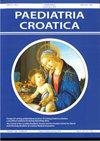Molecular genetics analysis of osteogenesis imperfecta in clinical practice
Q4 Medicine
引用次数: 1
Abstract
Osteogenesis imperfecta (OI) is characterized by fractures with minimal or absent trauma, representing a continuum ranging from perinatal lethality through individuals with severe skeletal deformities to nearly asymptomatic individuals with mild predisposition to fractures. Diagnosis of OI is an interdisciplinary task based on family and/or patient history of fractures combined with characteristic physical fi ndings. Radiographic examination reveals fractures of varying ages and stages of healing, wormian bones, and osteopenia. As there is no defi nitive test for OI, molecular genetic testing by next generation sequencing (NGS) of COL1A1 and COL1A2 and up to 12 other genes is essential to confi rm the genetic background. Therefore, we designed a NGS gene panel comprising 12 genes involved in OI or severe osteoporosis. Here we report results in a cohort of 11 apparently sporadic young patients with OI, all off spring of unaff ected parents, who were referred to orthopaedic surgery at Sv. Katarina Special Hospital (Zabok/Zagreb, Croatia). Ten of these 11 patients could be classifi ed genetically. Overall, three genes with diff erent percent relating to the whole cohort were involved: COL1A1 (63.6%), COL1A2 (18.18%) and WNT1 (9.09%).临床应用中成骨不全的分子遗传学分析
成骨不全症(OI)的特征是创伤最小或无创伤的骨折,表现为从围产期死亡到严重骨骼畸形的个体,再到几乎无症状的轻度骨折倾向的个体。OI的诊断是一项跨学科的任务,基于骨折的家族和/或患者病史,并结合特征性的身体发现。射线照相检查显示不同年龄和愈合阶段的骨折、蠕虫骨和骨质减少。由于没有明确的OI测试,通过COL1A1和COL1A2以及多达12个其他基因的下一代测序(NGS)进行分子遗传测试对于确认遗传背景至关重要。因此,我们设计了一个NGS基因组,包括12个与OI或严重骨质疏松症有关的基因。在这里,我们报告了一组11名明显散发的年轻OI患者的结果,他们都是未感染的父母,他们被转诊到Sv.Katarina特殊医院(克罗地亚扎博克/萨格勒布)接受整形外科手术。这11例患者中有10例可以进行基因分类。总体而言,涉及三个与整个队列相关的百分比不同的基因:COL1A1(63.6%)、COL1A2(18.18%)和WNT1(9.09%)。
本文章由计算机程序翻译,如有差异,请以英文原文为准。
求助全文
约1分钟内获得全文
求助全文
来源期刊

Paediatria Croatica
医学-小儿科
CiteScore
0.20
自引率
0.00%
发文量
0
审稿时长
6-12 weeks
期刊介绍:
In the inaugural 1956 issue of the journal, the editor Dr Feđa Fischer Sartorius outlined the journal''s vision and objectives saying that the journal will publish original papers on the development, pathology, and health care of children from the prenatal period to their final biological, emotional and social maturity. The journal continues this vision by publishing original research articles, clinical and laboratory observations, case reports and reviews of medical progress in pediatrics and child health.
 求助内容:
求助内容: 应助结果提醒方式:
应助结果提醒方式:


